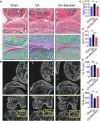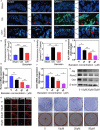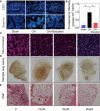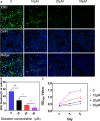Baicalein alleviates osteoarthritis by protecting subchondral bone, inhibiting angiogenesis and synovial proliferation
- PMID: 33939310
- PMCID: PMC8178278
- DOI: 10.1111/jcmm.16538
Baicalein alleviates osteoarthritis by protecting subchondral bone, inhibiting angiogenesis and synovial proliferation
Abstract
Osteoarthritis (OA) is one of the most frequent chronic joint diseases with the increasing life expectancy. The main characteristics of the disease are loss of articular cartilage, subchondral bone sclerosis and synovium inflammation. Physical measures, drug therapy and surgery are the mainstay of treatments for OA, whereas drug therapies are mainly limited to analgesics, glucocorticoids, hyaluronic acids and some alternative therapies because of single therapeutic target of OA joints. Baicalein, a traditional Chinese medicine extracted from Scutellaria baicalensis Georgi, has been widely used in anti-inflammatory therapies. Previous studies revealed that baicalein could alleviate cartilage degeneration effectively by acting on articular chondrocytes. However, the mechanisms involved in baicalein-mediated protection of the OA are not completely understood in consideration of integrality of arthrosis. In this study, we found that intra-articular injection of baicalein ameliorated subchondral bone remodelling. Further studies showed that baicalein could decrease the number of differentiated osteoblasts by inhibiting pre-osteoblasts proliferation and promoting pre-osteoblasts apoptosis. In addition, baicalein impaired angiogenesis of endothelial cells and inhibited proliferation of synovial cells. Taken together, these results implicated that baicalein might be an effective medicine for treating OA by regulating multiple targets.
Keywords: angiogenesis; baicalein; osteoarthritis; subchondral bone; synovitis.
© 2021 The Authors. Journal of Cellular and Molecular Medicine published by Foundation for Cellular and Molecular Medicine and John Wiley & Sons Ltd.
Conflict of interest statement
The authors declare that they have no competing interests.
Figures






Similar articles
-
Baicalein Alleviates Osteoarthritis Progression in Mice by Protecting Subchondral Bone and Suppressing Chondrocyte Apoptosis Based on Network Pharmacology.Front Pharmacol. 2022 Jan 10;12:788392. doi: 10.3389/fphar.2021.788392. eCollection 2021. Front Pharmacol. 2022. PMID: 35082670 Free PMC article.
-
Cartilage degradation in osteoarthritis: A process of osteochondral remodeling resembles the endochondral ossification in growth plate?Med Hypotheses. 2018 Dec;121:183-187. doi: 10.1016/j.mehy.2018.08.023. Epub 2018 Aug 27. Med Hypotheses. 2018. PMID: 30396477
-
Inhibited osteoclastic bone resorption through alendronate treatment in rats reduces severe osteoarthritis progression.Bone. 2014 Sep;66:163-70. doi: 10.1016/j.bone.2014.06.009. Epub 2014 Jun 13. Bone. 2014. PMID: 24933343
-
Do immune cells lead the way in subchondral bone disturbance in osteoarthritis?Prog Biophys Mol Biol. 2019 Nov;148:21-31. doi: 10.1016/j.pbiomolbio.2017.12.004. Epub 2017 Dec 22. Prog Biophys Mol Biol. 2019. PMID: 29277342 Review.
-
Therapeutics in Osteoarthritis Based on an Understanding of Its Molecular Pathogenesis.Int J Mol Sci. 2018 Feb 27;19(3):674. doi: 10.3390/ijms19030674. Int J Mol Sci. 2018. PMID: 29495538 Free PMC article. Review.
Cited by
-
Vindoline Attenuates Osteoarthritis Progression Through Suppressing the NF-κB and ERK Pathways in Both Chondrocytes and Subchondral Osteoclasts.Front Pharmacol. 2022 Jan 12;12:764598. doi: 10.3389/fphar.2021.764598. eCollection 2021. Front Pharmacol. 2022. PMID: 35095488 Free PMC article.
-
A Baicalin-Based Functional Polymer in Dynamic Reversible Networks Alleviates Osteoarthritis by Cellular Interactions.Adv Sci (Weinh). 2025 Mar;12(10):e2410951. doi: 10.1002/advs.202410951. Epub 2025 Jan 22. Adv Sci (Weinh). 2025. PMID: 39840483 Free PMC article.
-
Baicalein suppresses inflammation and attenuates acute lung injury by inhibiting glycolysis via HIF‑1α signaling.Mol Med Rep. 2025 Jan;31(1):18. doi: 10.3892/mmr.2024.13383. Epub 2024 Nov 8. Mol Med Rep. 2025. PMID: 39513601 Free PMC article.
-
The role of cells and signal pathways in subchondral bone in osteoarthritis.Bone Joint Res. 2023 Sep 8;12(9):536-545. doi: 10.1302/2046-3758.129.BJR-2023-0081.R1. Bone Joint Res. 2023. PMID: 37678837 Free PMC article.
-
Phytochemicals against Osteoarthritis by Inhibiting Apoptosis.Molecules. 2024 Mar 27;29(7):1487. doi: 10.3390/molecules29071487. Molecules. 2024. PMID: 38611766 Free PMC article. Review.
References
-
- Kuroki K, Cook CR, Cook JL. Subchondral bone changes in three different canine models of osteoarthritis. Osteoarthritis Cartilage. 2011;19:1142‐1149. - PubMed
-
- Carballo CB, Nakagawa Y, Sekiya I, Rodeo SA. Basic science of articular cartilage. Clin Sports Med. 2017;36:413‐425. - PubMed
-
- Armiento AR, Stoddart MJ, Alini M, Eglin D. Biomaterials for articular cartilage tissue engineering: learning from biology. Acta Biomater. 2018;65:1‐20. - PubMed
Publication types
MeSH terms
Substances
Grants and funding
LinkOut - more resources
Full Text Sources
Other Literature Sources
Medical

